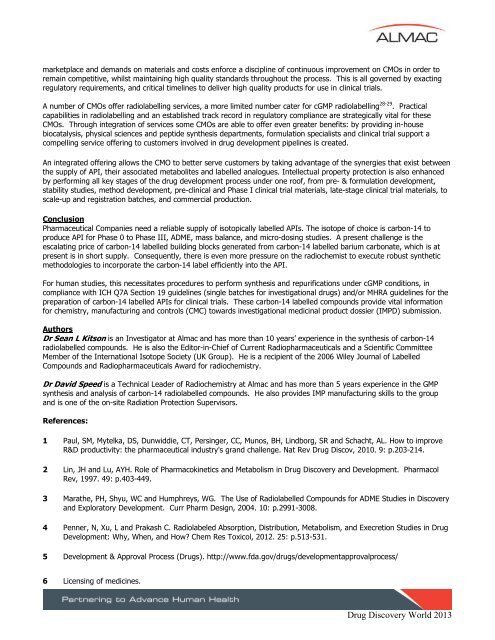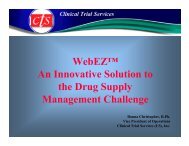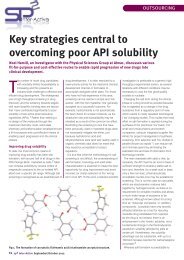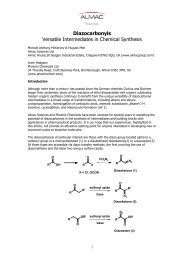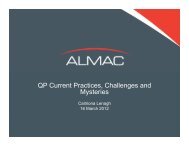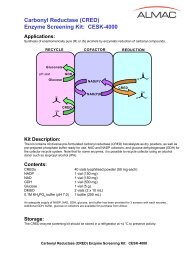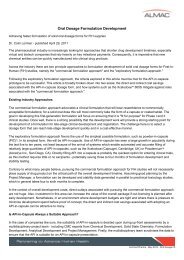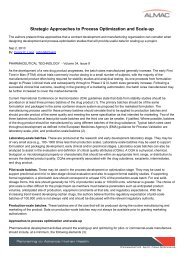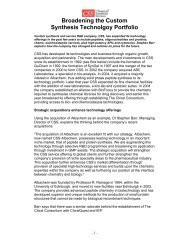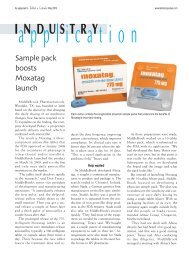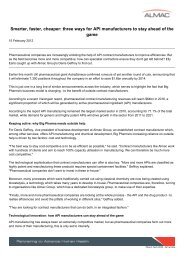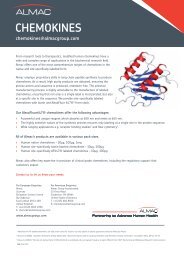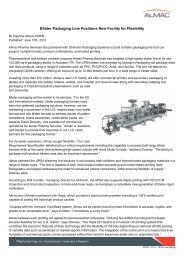CARBON-14 LABELLED API MANUFACTURING - Almac
CARBON-14 LABELLED API MANUFACTURING - Almac
CARBON-14 LABELLED API MANUFACTURING - Almac
You also want an ePaper? Increase the reach of your titles
YUMPU automatically turns print PDFs into web optimized ePapers that Google loves.
marketplace and demands on materials and costs enforce a discipline of continuous improvement on CMOs in order to<br />
remain competitive, whilst maintaining high quality standards throughout the process. This is all governed by exacting<br />
regulatory requirements, and critical timelines to deliver high quality products for use in clinical trials.<br />
A number of CMOs offer radiolabelling services, a more limited number cater for cGMP radiolabelling 28-29 . Practical<br />
capabilities in radiolabelling and an established track record in regulatory compliance are strategically vital for these<br />
CMOs. Through integration of services some CMOs are able to offer even greater benefits: by providing in-house<br />
biocatalysis, physical sciences and peptide synthesis departments, formulation specialists and clinical trial support a<br />
compelling service offering to customers involved in drug development pipelines is created.<br />
An integrated offering allows the CMO to better serve customers by taking advantage of the synergies that exist between<br />
the supply of <strong>API</strong>, their associated metabolites and labelled analogues. Intellectual property protection is also enhanced<br />
by performing all key stages of the drug development process under one roof, from pre- & formulation development,<br />
stability studies, method development, pre-clinical and Phase I clinical trial materials, late-stage clinical trial materials, to<br />
scale-up and registration batches, and commercial production.<br />
Conclusion<br />
Pharmaceutical Companies need a reliable supply of isotopically labelled <strong>API</strong>s. The isotope of choice is carbon-<strong>14</strong> to<br />
produce <strong>API</strong> for Phase 0 to Phase III, ADME, mass balance, and micro-dosing studies. A present challenge is the<br />
escalating price of carbon-<strong>14</strong> labelled building blocks generated from carbon-<strong>14</strong> labelled barium carbonate, which is at<br />
present is in short supply. Consequently, there is even more pressure on the radiochemist to execute robust synthetic<br />
methodologies to incorporate the carbon-<strong>14</strong> label efficiently into the <strong>API</strong>.<br />
For human studies, this necessitates procedures to perform synthesis and repurifications under cGMP conditions, in<br />
compliance with ICH Q7A Section 19 guidelines (single batches for investigational drugs) and/or MHRA guidelines for the<br />
preparation of carbon-<strong>14</strong> labelled <strong>API</strong>s for clinical trials. These carbon-<strong>14</strong> labelled compounds provide vital information<br />
for chemistry, manufacturing and controls (CMC) towards investigational medicinal product dossier (IMPD) submission.<br />
Authors<br />
Dr Sean L Kitson is an Investigator at <strong>Almac</strong> and has more than 10 years’ experience in the synthesis of carbon-<strong>14</strong><br />
radiolabelled compounds. He is also the Editor-in-Chief of Current Radiopharmaceuticals and a Scientific Committee<br />
Member of the International Isotope Society (UK Group). He is a recipient of the 2006 Wiley Journal of Labelled<br />
Compounds and Radiopharmaceuticals Award for radiochemistry.<br />
Dr David Speed is a Technical Leader of Radiochemistry at <strong>Almac</strong> and has more than 5 years experience in the GMP<br />
synthesis and analysis of carbon-<strong>14</strong> radiolabelled compounds. He also provides IMP manufacturing skills to the group<br />
and is one of the on-site Radiation Protection Supervisors.<br />
References:<br />
1 Paul, SM, Mytelka, DS, Dunwiddie, CT, Persinger, CC, Munos, BH, Lindborg, SR and Schacht, AL. How to improve<br />
R&D productivity: the pharmaceutical industry's grand challenge. Nat Rev Drug Discov, 2010. 9: p.203-2<strong>14</strong>.<br />
2 Lin, JH and Lu, AYH. Role of Pharmacokinetics and Metabolism in Drug Discovery and Development. Pharmacol<br />
Rev, 1997. 49: p.403-449.<br />
3 Marathe, PH, Shyu, WC and Humphreys, WG. The Use of Radiolabelled Compounds for ADME Studies in Discovery<br />
and Exploratory Development. Curr Pharm Design, 2004. 10: p.2991-3008.<br />
4 Penner, N, Xu, L and Prakash C. Radiolabeled Absorption, Distribution, Metabolism, and Execretion Studies in Drug<br />
Development: Why, When, and How? Chem Res Toxicol, 2012. 25: p.513-531.<br />
5 Development & Approval Process (Drugs). http://www.fda.gov/drugs/developmentapprovalprocess/<br />
6 Licensing of medicines.<br />
Drug Discovery World 2013


